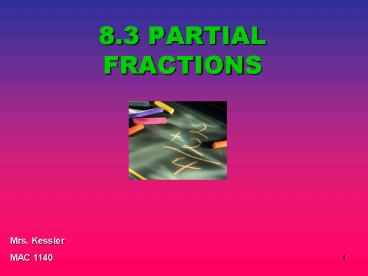8'3 PARTIAL FRACTIONS - PowerPoint PPT Presentation
1 / 21
Title:
8'3 PARTIAL FRACTIONS
Description:
We clear fractions, multiplying both sides by x(x 3)2, the least common denominator. ... We clear fractions, multiplying both sides by (x - 2) (x2 2x 4) ... – PowerPoint PPT presentation
Number of Views:45
Avg rating:3.0/5.0
Title: 8'3 PARTIAL FRACTIONS
1
8.3 PARTIAL FRACTIONS
Mrs. Kessler MAC 1140
2
What is Partial Fractions?
- It is a method to decompose fractions into their
components.
3
Steps in Partial Fraction Decomposition
- 1. Set up the partial fraction decomposition with
the unknown constants A, B, C, etc., in the
numerator of the composition. - 2. Multiply both sides of the resulting equation
by the least common denominator. - 3. Substitute values into the equation to solve
for A, B,C etc. - 4. Substitute the values for A, B, C, etc., into
the equation in the first step.
4
Example 1
Find the partial fraction decomposition of
Step 1 Set up the partial fraction
decomposition with the unknown constants.
Step 2. Multiply both sides of the resulting
equation by the least common denominator.
Step 3 . Choose a value of x to substitute into
the equation hoping to eliminate A or B.
5
Example 1 contd.
Step 3 . Choose a value of x to substitute into
the equation hoping to eliminate A or B.
Let x 3
Repeat.
6
Example 1 contd.
Step 3 . Choose a value of x to substitute into
the equation hoping to eliminate A or B.
Let x -2
Step 4 Rewrite original fraction.
7
Example 1 contd.
8
Example 2
Find the partial fraction decomposition of
Step 1 Set up the partial fraction
decomposition with the unknown constants.
Because the linear factor x 3 is repeated
twice, we must include one fraction with a
constant numerator for each power of (x 3).
Step 2. Multiply both sides of the resulting
equation by the least common denominator.
9
Example 2 contd.
Step 2 Multiply both sides of the resulting
equation by the least common denominator. We
clear fractions, multiplying both sides by x(x
3)2, the least common denominator.
We use the distributive property on the right
side.
Dividing out common factors in numerators and
denominators, we obtain x 18 A(x 3)2 Bx(x
3) Cx.
10
Text 3 contd.
x 18 A(x 3)2 Bx(x 3) Cx.
Choose x 3
3 18 A(3 3)2 B(3)(3 3) C(3)
15 (3)C
C -5
Choose another value, x 0
18 A(0 3)2 B(0)(0 3) C(0)
18 9A
A -2
Choose another value , x 1
1 18 A(1 3)2 B1(1 3) C1.
11
Ex. 3 contd.
A -2
C -5
x 18 A(x 3)2 Bx(x 3) Cx.
1 18 A(1 3)2 B1(1 3) C1.
-17 4A -2B C.
-17 4(-2) -2B (-5).
B 2
12
Example 4
Find the partial fraction decomposition of
13
Example 4 cont.
Step 2 Multiply both sides of the resulting
equation by the least common denominator. We
clear fractions, multiplying both sides by (x -
2) (x2 2x 4), the least common denominator.
We use the distributive property on the right
side.
Dividing out common factors in numerators and
denominators, we obtain 3x2 17x 14 A(x2
2x 4) (Bx C)(x - 2).
14
Example 4 cont.
3x2 17x 14 A(x2 2x 4) (Bx C)(x -
2).
Choose x 2
60 12A (Bx C)(2 - 2).
A 5
Choose x 0
14 A(4) (C)(- 2).
C 3
15
Example 4 cont.
3x2 17x 14 A(x2 2x 4) (Bx C)(x -
2).
Choose x 1
34 7A (B C)(-1).
A 5
C 3
Sub A and C in and solve for B
B -2
16
Example 4 cont.
A 5
C 3
B -2
17
Example 5 Try this!
- Find the partial fraction decomposition of
Set up
Multiply by CD
Choose x 3
A 5/3
18
Example 5 Try this!
- Find the partial fraction decomposition of
Choose x - 3
B 4/3
A 5/3
19
Example 6
Find the partial fraction decomposition of
20
(No Transcript)
21
TOMORROW 8.4

